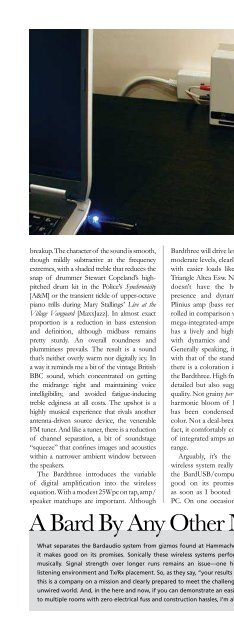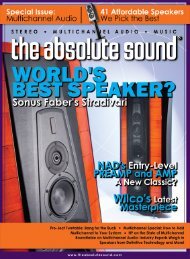You also want an ePaper? Increase the reach of your titles
YUMPU automatically turns print PDFs into web optimized ePapers that Google loves.
eakup. The character of the sound is smooth,<br />
though mildly subtractive at the frequency<br />
extremes, with a shaded treble that reduces the<br />
snap of drummer Stewart Copeland’s highpitched<br />
drum kit in the Police’s Synchronicity<br />
[A&M] or the transient tickle of upper-octave<br />
piano trills during Mary Stallings’ Live at the<br />
Village Vanguard [MaxxJazz]. In almost exact<br />
proportion is a reduction in bass extension<br />
and definition, although midbass remains<br />
pretty sturdy. An overall roundness and<br />
plumminess prevails. The result is a sound<br />
that’s neither overly warm nor digitally icy. In<br />
a way it reminds me a bit of the vintage British<br />
BBC sound, which concentrated on getting<br />
the midrange right and maintaining voice<br />
intelligibility, and avoided fatigue-inducing<br />
treble edginess at all costs. The upshot is a<br />
highly musical experience that rivals another<br />
antenna-driven source device, the venerable<br />
FM tuner. And like a tuner, there is a reduction<br />
of channel separation, a bit of soundstage<br />
“squeeze” that confines images and acoustics<br />
within a narrower ambient window between<br />
the speakers.<br />
The Bardthree introduces the variable<br />
of digital amplification into the wireless<br />
equation. With a modest 25Wpc on tap, amp/<br />
speaker matchups are important. Although<br />
Bardthree will drive less sensitive speakers to<br />
moderate levels, clearly it performed its best<br />
with easier loads like the 91.5dB-sensitive<br />
Triangle Altea Esw. Naturally, the Bardthree<br />
doesn’t have the hulking low-frequency<br />
presence and dynamics of an MBL or<br />
Plinius amp (bass remains a little soft and<br />
rolled in comparison with these high-output<br />
mega-integrated-amps), but the Bardthree<br />
has a lively and highly resolved midrange,<br />
with dynamics and resolution to match.<br />
Generally speaking, its sound fell into line<br />
with that of the standalone Rx module, but<br />
there is a coloration in the treble unique to<br />
the Bardthree. High frequencies are clear and<br />
detailed but also suggest a thinner, papery<br />
quality. Not grainy per se, but a sense that the<br />
harmonic bloom of high strings and brass<br />
has been condensed and desaturated of<br />
color. Not a deal-breaker by any stretch—in<br />
fact, it comfortably compares with a variety<br />
of integrated amps and receivers in its price<br />
range.<br />
Arguably, it’s the BardUSB where the<br />
wireless system really shines. In my system<br />
the BardUSB/computer connection made<br />
good on its promise to “plug-and-play”<br />
as soon as I booted up iTunes aboard my<br />
PC. On one occasion when I inserted the<br />
A Bard By Any Other Name<br />
What separates the Bardaudio system from gizmos found at Hammacher Schlemmer is that<br />
it makes good on its promises. Sonically these wireless systems performed admirably and<br />
musically. Signal strength over longer runs remains an issue—one highly dependant on<br />
listening environment and Tx/Rx placement. So, as they say, “your results may vary.” That said,<br />
this is a company on a mission and clearly prepared to meet the challenges of an increasingly<br />
unwired world. And, in the here and now, if you can demonstrate an easier way to pipe music<br />
to multiple rooms with zero electrical fuss and construction hassles, I’m all ears. NG<br />
The<br />
Fine Print<br />
Bardaudio advertises wireless performance<br />
between roughly 60 and 120 feet. In<br />
practice these are idealized figures.<br />
The reality is that wireless systems are<br />
prisoners of the infinite number of interior<br />
obstacles they must face. A transmitter<br />
that “sees” fifty unobstructed feet in<br />
front of it performs very differently than<br />
one confronted with a couple of lathand-plaster<br />
walls. So the real test of the<br />
Bardaudio’s prowess was transmitting to<br />
another room. In my home, the system<br />
began breaking up slightly beyond fortyto-fifty<br />
feet with a one-wall obstruction—<br />
basically at the low side of the stated spec.<br />
Without obstructions, throw distance<br />
increases markedly.<br />
Also be prepared to don your tweaker’s<br />
hat in order to optimize the signal—small<br />
shifts of the Tx/Rx modules (which are<br />
also antennae, after all) are needed to<br />
lock in the signal, much like the time we<br />
all spend positioning speakers to accord<br />
with the listening-position “sweetspot.”<br />
Placement on higher shelves is a distinct<br />
advantage. Even so, at or near the limits<br />
of reception, there will be the occasional<br />
dropout, heard as a vinyl-record-like lowlevel<br />
tick or snap. NG<br />
BardUSB with the PC already powered up,<br />
I got a conflict message from my LinkSys<br />
router, but I simply mouse-clicked “Repair”<br />
in the Windows XP Wireless Network<br />
Connection Status menu, and the software<br />
automatically sought a different channel for<br />
my DSL. It took hardly a minute, the bluelight<br />
connection indicator on the BardUSB<br />
shone brightly, and I was back up and<br />
running. Note: CD playback was consistent<br />
with my results for the Tx, but performance<br />
was about what I’ve come to expect from<br />
a highly compressed formats like iTunes—<br />
sonics are lightweight with a whitish cast,<br />
dynamically squeezed, and generally bereft<br />
of low-level detail. But none of this was the<br />
fault of the BardUSB, which went about its<br />
appointed rounds admirably, transmitting<br />
without drama or dropouts.<br />
I need to add that, on a broader<br />
philosophical basis, what makes the<br />
BardUSB a home run is its potential to bridge<br />
the technological and generational divide<br />
between computer users (read: younger)<br />
and high-end audio hobbyists (older). It has<br />
the power to open up a dialogue between<br />
what makes these two worlds tick. And any<br />
device that underscores compatibility rather<br />
than divisiveness is a worthy addition to the<br />
wider audio conversation. TAS<br />
December 2006 The Absolute Sound 35










